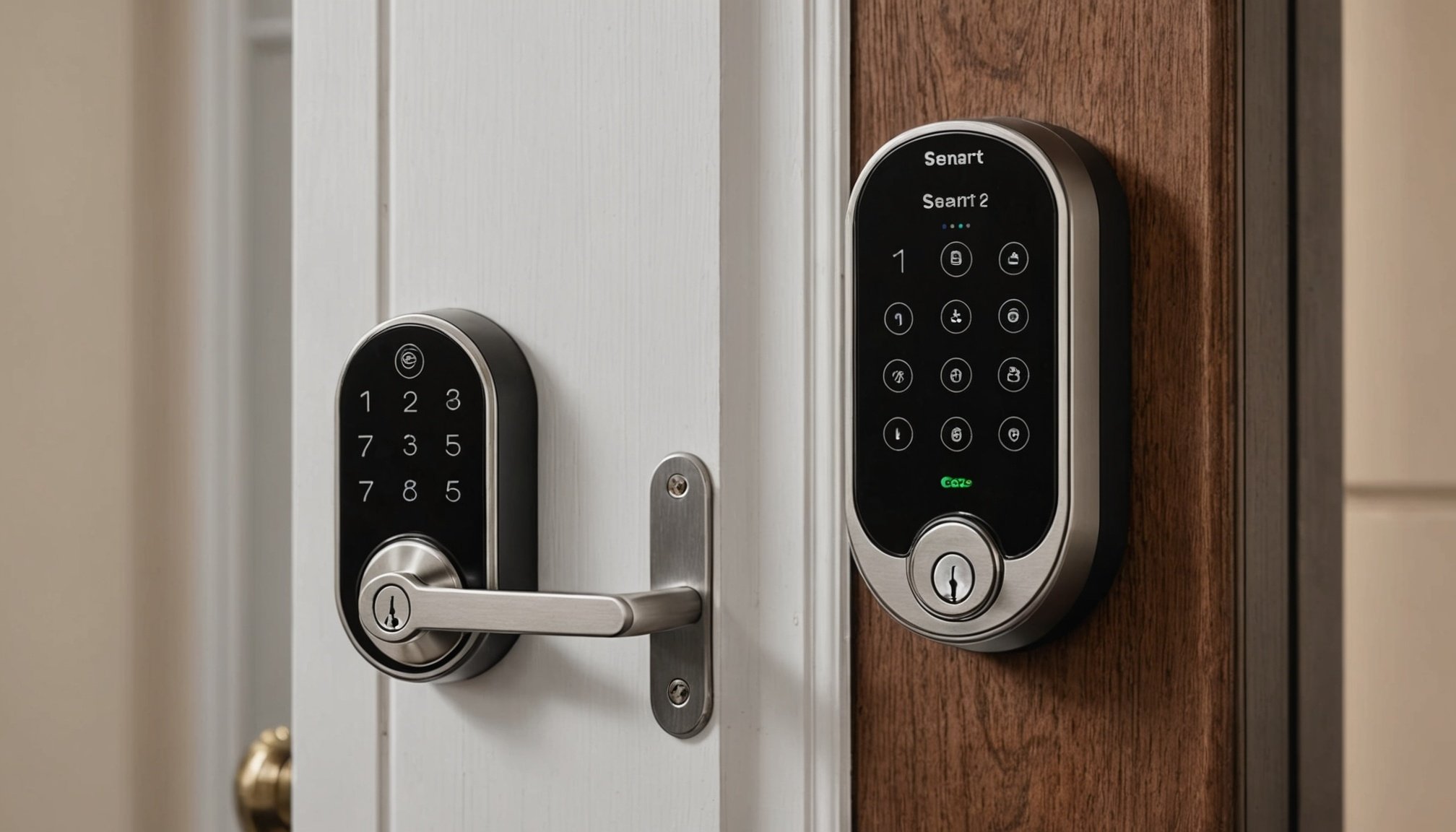Benefits of Smart Locks
Smart locks offer a range of advantages over traditional locks, serving as a key upgrade in enhancing home security. These devices integrate sophisticated security features that make homes safer, protecting them more effectively than standard door hardware.
A significant feature of smart locks is smartphone integration, which allows users to monitor and control their locks remotely. This functionality provides the convenience of accessing locks from anywhere, using a simple app on a mobile device. Such technology not only simplifies daily life but also ensures peace of mind, as homeowners can lock or unlock doors without needing to be physically present.
Also to discover : Elevate your smartphone to a smart garden control center: a comprehensive step-by-step guide
Another advantage of smart locks is their ability to send real-time notifications. This feature keeps homeowners informed about every lock/unlock event, increasing the overall sense of safety and allowing for prompt responses to unexpected activities. Notifications can alert users immediately if someone attempts to enter their home unauthorised or if a family member arrives home safely.
In summary, the integration of technology into home security through smart locks remarkably improves convenience and safety. The enhanced security options they offer, combined with the ability to manage them through a smartphone, firmly establish them as a proactive choice for modern home security solutions.
This might interest you : Mastering smart irrigation: effortlessly control your home watering system with your smartphone
Key Features of Smart Locks
Smart locks have revolutionised the way we secure our homes by offering a variety of advanced features and seamless integrations with other technologies. Among the most popular types are keyless entry and biometric systems. Keyless entry smart locks allow users to unlock their doors using codes or smartphones, eliminating the need for traditional keys. Biometric locks take security a step further by using fingerprints or other unique identifiers, offering a robust and personalised security solution.
A significant advantage of smart locks is their compatibility with mobile app functionalities. These apps enable users to perform crucial actions such as locking or unlocking doors remotely. Additionally, they provide real-time notifications for monitoring door activity, offering peace of mind when away from home. This capability ensures that users can manage access efficiently and securely.
To enhance convenience, smart locks can seamlessly integrate with smart home systems like Alexa or Google Home. This integration allows users to operate their locks through voice commands, adding another layer of convenience to home security. As technology in smart locks evolves, these features are becoming indispensable, providing innovative solutions for modern living. Thus, for those keen on elevating their security while embracing cutting-edge technology, investing in smart locks is a wise choice.
Setting Up Your Smart Lock
Smart lock installation can vary based on the type, but understanding the setup process is crucial for ensuring your lock functions properly. Begin by identifying the model of your smart lock. Typically, installation involves removing your existing lock and replacing it with the new one. Most smart locks fit over a standard deadbolt.
Initial App Setup and Bluetooth Pairing
Once installed, the next step is integrating your smart lock with its associated smartphone app. Download the app from your device’s app store, and follow the on-screen prompts to create an account. Bluetooth pairing is integral during this process. Ensure Bluetooth is enabled on your smartphone. This allows the app to connect and communicate with your lock effectively.
Common Setup Issues and Troubleshooting Tips
Despite its simplicity, some users may encounter setup hurdles. If you face pairing issues, ensure your phone is within close proximity to the lock. Double-check that the lock has power; replacing batteries often resolves connectivity problems. If the app doesn’t recognize the lock, restarting your phone or reinstalling the app may help. These straightforward steps often solve initial setup concerns, enabling a seamless transition to smart locking technology.
Top Smart Lock Comparisons
Exploring the best smart locks requires a comprehensive glance at various options, each catering to unique needs and priorities.
Budget-Friendly Options
Delving into affordable solutions, smart lock comparisons reveal models like the Wyze Lock and August Smart Lock, known for their cost-effectiveness. These selections provide essential security features without breaking the bank, making them ideal for budget-conscious buyers. Notably, the Wyze Lock integrates seamlessly with existing deadbolts, offering a convenient and straightforward setup. Meanwhile, the August Smart Lock shines with its ability to connect with various home automation systems, granting flexibility in compatibility.
High-End Smart Locks
When reviewing product reviews of premium smart locks, the Schlage Encode and Yale Assure Lock SL emerge as leaders. These high-end options boast robust security measures, including voice assistant support and enhanced durability. Schlage’s Wi-Fi integration eliminates the need for external hubs, simplifying connectivity. Yale’s sleek design and touch screen pad offer both style and functionality, appealing to tech enthusiasts who value aesthetics alongside performance.
Versatile Smart Locks for Renters
For renters, choosing versatile smart locks can enhance convenience without permanent installation complications. Locks like the Level Bolt and Eufy Security Smart Lock stand out. These offer renter-friendly designs that easily adapt to existing doors, preserving lease terms while upgrading security. Renters gain from the non-intrusive installation and adaptable technology, ensuring peace of mind with their home protection solutions.
Security Tips for Using Smart Locks
Smart locks revolutionise home security by offering convenience combined with advanced features. However, to ensure maximum protection, it’s vital to adopt the right security measures.
Firstly, regularly updating your smart lock’s software is crucial. These updates often include patches for known vulnerabilities, directly improving the lock’s defences against unauthorised access. Therefore, always check for updates and install them promptly to maintain robust smart lock security.
Using strong, unique passwords is another essential practice. A password should be complex, combining uppercase and lowercase letters, numbers, and symbols. This complexity makes it harder for potential intruders to breach your system, effectively protecting your home.
Moreover, consider enabling additional security measures such as two-factor authentication (2FA). This adds an extra layer of security, requiring a second form of verification beyond just the password. For instance, you might need to enter a temporary code sent to your mobile device, making unauthorised access much more challenging.
By following these security best practices, you can significantly amplify the security of your smart lock, providing peace of mind and enhanced protection for your home. Staying informed and proactive is the key to leveraging technology safely and effectively.
Troubleshooting Common Issues
When it comes to smart lock problems, understanding common connectivity problems is crucial. If your smart lock is not responding, the first step in our troubleshooting guide is to check the Wi-Fi or Bluetooth connection. Often, connectivity issues can be resolved by moving the lock and the home router closer together or ensuring that there are no major obstructions between them. For remedying app issues, confirm that both the lock firmware and app software are up-to-date. Reinstallation of the app can also be a simple yet effective solution.
Battery issues are another frequent concern. Smart locks typically alert users when battery life is low. It’s imperative to change batteries promptly to avoid lockouts. High-quality alkaline batteries are recommended for optimal performance. Regular battery maintenance includes checking for corrosion and ensuring batteries are seated correctly.
If experiencing persistent issues, knowing how to reset your smart lock is valuable skill. Most smart locks can be reset by following manufacturer instructions, often involving a small reset button on the device. Additionally, resetting the lock can also resolve app connectivity issues. Re-pair the device with your app after a reset to restore full functionality. By following these steps, you can manage most common smart lock problems effectively.










